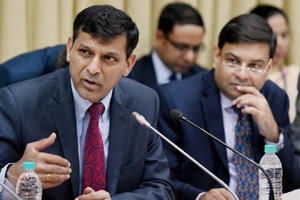Before cutting policy rates any further, RBI would wait for cues from the Union Budget and inflation numbers, governor Raghuram Rajan said on Tuesday. Excerpts from a media interaction:
How do you see the CPI path hereon?
I would reiterate that we are looking for developments on both disinflationary and fiscal fronts. The forthcoming Budget is an important development. Our hope is that oil prices will stay low. As these low prices feed into prices more generally, it would help the disinflationary process. A relative stable exchange rate would also help. Until we get more data, we are on pause.
What real interest rate level would you be comfortable with?
We think 1.5-2% is a reasonable real rate…
What is your take on the new series of GDP numbers?
We need to spend more time understanding the GDP numbers. We would be watching February 9 releases with great care. At this point, it is premature to take a strong view based on these numbers. Most of the data for 2013-14, except inflation, give us a sense that economic growth was sluggish. We find it hard to see the economy as rollicking in FY14. However, we must understand why the numbers were such. It could be that the services sector contributed to this.
Will you nudge banks to transmit more of your rate cuts?
We cannot nudge them. We can only comment on the fact that despite a substantial fall in treasury and corporate bond rates, bank lending rates have remained more or less flat. Some movement on new loans has been there, but, in general, base rates haven’t changed. I think it is the pressure of the competition that will eventually force banks to pass through these rate cuts. They are facing competition from money market instruments.
Do you think banks should lend to accounts that are NPAs already?
I think we should not attribute stigma to an NPA. It just means that the account is not paying and there could be legitimate reasons for that.
Will you consider extending the deadline for restructured loan classification beyond April 1?
I have said repeatedly that it is important that we clean up the bank balance sheet. To enhance confidence in bank balance sheets, we have to put an end to forbearance. We have given enormous flexibility. But I don’t think the answer is to pretend and extend (the deadline) and, again, pretend.
Do you think there is a risk of sharp appreciation of the rupee?
At present, it would be wrong to say that we have become grossly uncompetitive. We do not intervene to target a level of exchange rate. Where we do intervene is to reduce volatility and we have intervened in both directions in recent months and weeks. We are perfectly comfortable with where the rupee is. But, going forward, with the massive amount of quantitative easing in the rest of the world, there are possible dangers of us becoming uncompetitive.
Why not open up investment limit for longer term investors instead of allowing reinvestment of coupons?
We want to manage the country’s balance sheet to make sure it is bullet-proof for times when the inevitable US interest rate hikes come. If we just expand the limits by, say, $5 billion, it would be taken up in a couple of weeks and, then, we would be asked to hike it again. We thought a more streamlined way of doing it is allowing reinvestment of the interest.

